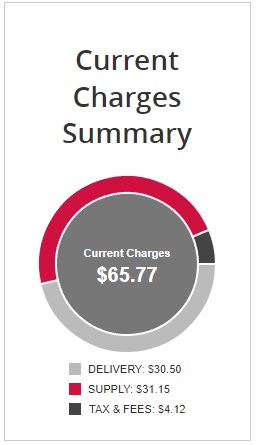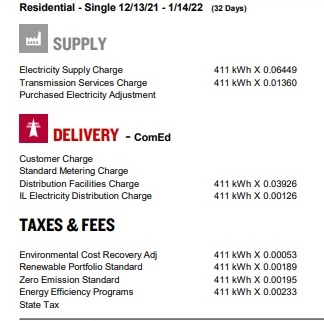 Simple rule: In order to predict savings, one must first know their costs. As we have discussed previously in Saving on Heating Related Costs & Energy Savings & Efficiency 101, there are only 3 ways to reduce costs: reduce usage / conserve, improve performance, or change fuel sources.
Simple rule: In order to predict savings, one must first know their costs. As we have discussed previously in Saving on Heating Related Costs & Energy Savings & Efficiency 101, there are only 3 ways to reduce costs: reduce usage / conserve, improve performance, or change fuel sources.
For years most of us would get a bill that says – hey your kWh charge is 9.1¢ so you know that if you cut back 100 kWh you could save $9.10 or if you increased your usage the inverse would be true.
Some bills like the one shown in the Energy Savings piece above, didn’t have the number in bold. But with a little math you could easily figure out that for 503 kWh @ 71.89 = I paid 14.3¢ per kWh.
Nowadays with so many fees and taxes being topped off by requirements to split off delivery from electric supply, most utilities can’t easily give you that cost. That leads us to the first graphic you see. So how can you calculate anything off of that? Fortunately, all fees have to be disclosed (at least in most states if not all) so you might now see something like this second graphic:
 While it might not be fun, you can add up all the X 0.0XXXX numbers & in my case I know that my actual cost is 12.531¢ per kWh. If you do the same, you will know what your number is and how much reducing or adding X amount of kWh would do to your bill. (Hmm maybe a 4th option is moving, nah they will nail you some other way)
While it might not be fun, you can add up all the X 0.0XXXX numbers & in my case I know that my actual cost is 12.531¢ per kWh. If you do the same, you will know what your number is and how much reducing or adding X amount of kWh would do to your bill. (Hmm maybe a 4th option is moving, nah they will nail you some other way)
Oops, not so fast:
The statement above is accurate unless you are talking solar, wind, hydro or other power generation situation you might have. In that case you really would need to refer to their “net-metering” or other agreement your electric provider might have with you. In many cases they will only give you X amount for electricity flowing in but would charge you for all “delivery” related items.
Time of Use:
I would be remiss not to mention time of use plans. These are generally pretty straightforward as they say hey, between these hours, we will charge you X but during these hours you only pay Y. Be slightly careful as that might be limited to the supply only charges, so other fees may still apply not only to “normal” use but even if you are adding say an electric car charger (i.e. the almost 5¢ of delivery / taxes & fees I show above.) If in doubt talk with your provider but hopefully this gave you a good basis to start figuring out true costs.
